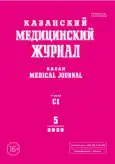Psychological characteristics of patients with primary dysmenorrhea
- Authors: Makaricheva EV1, Burguvan MS1
-
Affiliations:
- Kazan State Medical University
- Issue: Vol 101, No 5 (2020)
- Pages: 760-767
- Section: Clinical experiences
- Submitted: 18.06.2020
- Accepted: 15.09.2020
- Published: 27.10.2020
- URL: https://kazanmedjournal.ru/kazanmedj/article/view/34773
- DOI: https://doi.org/10.17816/KMJ2020-760
- ID: 34773
Cite item
Abstract
Aim. To study the psychological characteristics of women with primary dysmenorrhea.
Methods. We examined 77 women of childbearing age, divided into the main (40 women) and control (37 women) groups. The criterion for inclusion in the main group was a clinically confirmed diagnosis of “primary dysmenorrhea” with a regular menstrual cycle. The exclusion criteria were an organic gynecological pathology, a diagnosis of secondary dysmenorrhea and an irregular menstrual cycle. The criterion for inclusion in the control group was absolute painlessness of menstruation and the absence of gynecological diseases. The survey was conducted using psychodiagnostic techniques: a method for self-assessment of anxiety, rigidity, and extroversion; test “Express diagnosis of the level of self-esteem”; a technique for studying accentuation of personality traits; test-questionnaire of psychological defense mechanisms “Life Style Index”; questionnaire “Methods of coping behavior”, statistical methods. Also, a specially developed questionnaire was used, including questions related to socio-psychological parameters, as well as the nature and intensity of pain.
Results. Significant differences between the groups characterizing coping strategies were found: distance (p <0.002); escape-avoidance (p <0.029); psychological defenses: denial (p <0.006), regression (p <0.011). The subjects of the main group were characterized by significantly high anxiety levels (p <0.020) with the average score 47.2±1.15 corresponding to a hyperanxious and low self-esteem (p <0.001) with the average score 30.1±1.43 compared to women in the control group: 42.7±1.53 — average anxiety level and 27.4±1.31 — normal self-esteem.
Conclusion. The features of the relationship of the psychological characteristics of women with “primary dysmenorrhea” were revealed; it was proved that the subjects of the main and control groups differ in the features of coping behavior, psychological defenses and accentuation of personality traits, and also have reliably distinguishable levels of anxiety and self-esteem.
Full Text
About the authors
E V Makaricheva
Kazan State Medical University
Email: maria.ru97@mail.ru
Russian Federation, Kazan, Russia
M S Burguvan
Kazan State Medical University
Author for correspondence.
Email: maria.ru97@mail.ru
Russian Federation, Kazan, Russia
References
- Ayan M., Sogut E., Tas U. et al. Pain levels associated with renal colic and primary dysmenorrhea: a prospective controlled study with objective and subjective outcomes. Arch. Gynecol. Obstet. 2012; 286: 403–409. doi: 10.1007/s00404-012-2316-4.
- Pitangui A.C., Gomes M.R., Lima A.S. et al. Menstruation disturbances: prevalence, characteristics, and effects on the activities of daily living among adolescent girls from Brazil. Pediatr. Adolesc. Gynecol. 2013; 26: 148–152. doi: 10.1016/j.jpag.2012.12.001.
- Mezhevitinova E.A. Contraception and women's health. Ginekologiya. 1998; (2): 29–39. (In Russ.)
- Mezhevitinova E.A., Rogovskaya S.I., Prilepskaya V.N. Dysmenorrhea. Vestnik akush. i ginekol. 1994: (3): 7–11. (In Russ.)
- Davis A.R. Primary dysmenorrhea in adolescent girls and treatment with oral contraceptives. J. Pediatr. Adolesc. Gynec. 2001; 14: 3–8.
- Dawood M.Y. Primary dysmenorrhea: аdvances in pathogenesis and management. Obstet. Gynecol. 2006; 108: 428–441. doi: 10.1016/S1083-3188(00)00076-0.
- Sinchihin S.P., Mamiev O.B., Suverneva A.A., Kakurin V.I. Dysmenorrhoea — modern attitude to etiology, pathogenesis, diagnostics, clinic and treatment (literature review). Astrakhanskiy meditsinskiy zhurnal. 2010; 5 (1): 35–43. (In Russ.)
- Kanonova T.A., Rustanovich Yu.G. The role of psychological support in the treatment of adolescent girls with dysmenorrheal. In: Sovremennye problemy podrostkovoy meditsiny i reproduktivnogo zdorov'ya molodezhi. Korotinskie chteniya. Sbornik trudov 2-y Vserossiyskoy nauchno-prakticheskoy konferentsii. (Modern problems of adolescent medicine and youth reproductive health. Korotin Readings. Proceedings of the 2nd All-Russian Scientific and Practical Conference.) Ed. by A.S. Simakhodsky, V.P. Novikov, M.F. Ippolitov. SPb.: Sankt-Peterburgskiy obshchestvennyy fond “Podderzhka meditsiny” (Sankt-Peterburg). 2018; 70–76. (In Russ.)
- Tyuvina N.A., Voronina E.O., Balabanova V.V., Goncharova E.M. The relationship and interaction of menstrual and generative function and depressive disorders in women. Neurology, neuropsychiatry, psychosomatics. 2018; 10 (2): 45–51. (In Russ.) doi: 10.14412/2074-2711-2018-2-45-51.
- Ushakova N.T., Tsogoev A.S., Tsallagova L.V. et al. The modern approach to complex therapy of primary dysmenorea. Vestnik novykh meditsinskikh tekhnologiy. 2012; (1): 137–138. (In Russ.)
- Golovanevskaya V.I. The nature of self-concept and the preference for coping behavior strategies. Moscow University psychology bulletin. 2003; (4): 30–36. (In Russ.)
- Isaev D.N. Emotsional'nyy stress, psikhosomaticheskie i somaticheskie rasstroystva u detey. (Emotional stress, psychosomatic and somatic disorders in children.) Sankt-Peterburg: Rech'. 2005; 400 p. (In Russ.)
- Gevorgyan A.P., Adamyan L.V., Arslanyan K.N. et al. The importance of premorbid background in the development of primary dysmenorrhea in adolescent girls. Problemy reproduktsii. 2019; (1): 60–65. (In Russ.) doi: 10.17116/repro20192501160.
- Banikarim C., Chaco M.R., Kelder S.H. Prevalence and impact of dysmenorrhea on Hispanic female adolescents. Arch. Pediatr. Adolesc. Med. 2000; 154: 1226–1229. doi: 10.1001/archpedi.154.12.1226.
- Smith Roger P. Netter’s obstetrics and gynecology. Elsevier. 2018; 617 p.
- Dermanova I.B. Method of self-assessment of anxiety, rigidity and extroversion (according to D. Moadsley). In: Diagnostica emotional’no-nravstvennogo razvitiya. (Diagnostics of emotional and moral development.) SPb. 2002; 129–132. (In Russ.)
- Fetiskin N.P., Kozlov V.V., Manuilov G.M. Express diagnostics of the level of self-esteem. In: Social’no-psyhologicheskaya diagnostic razvitiya lychnosti i malih grupp. (Socio-psychological diagnostics of the development of personality and small groups.) M.: Izd-vo Instituta psyhoterapii. 2002; 53–54. (In Russ.)
- Fetiskin N.P., Kozlov V.V., Manuilov G.M. Determination of personality and characterological accentuations (K. Leongard). In: Social’no-psyhologicheskaya diagnostic razvitiya lychnosti i malih grupp. (Socio-psychological diagnostics of the development of personality and small groups.) M.: Izd-vo Instituta psyhoterapii. 2002; 370–376. (In Russ.)
- Wasserman L.I. Test-questionnaire of psychological defense mechanisms “Index of life style”. In: Psyhologicheskaya diagnostic indexa zhiznennogo stilya. (Psychological diagnostics of the life style index.) SPb.: Sankt-Peterburgskiy nauchno-issledovatel’skiy psyhonevrologicheskiy institut. 2005; 54 р. (In Russ.)
- Kryukova T.L., Kuftyak E.V. Coping questionnaire (adaptation of WCQ methodology). Zhurnal practicheskogo psyhologa. 2007; (3): 93–112. (In Russ.)









